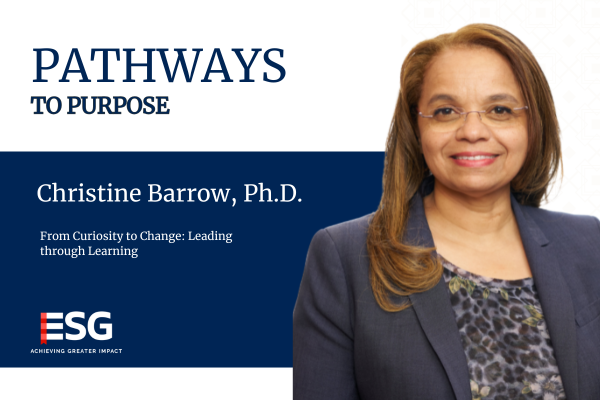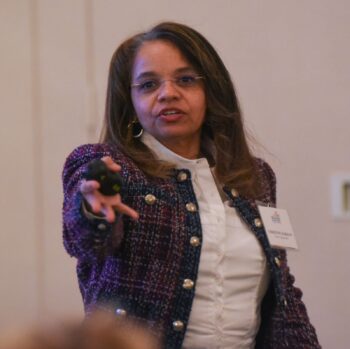Pathways to Purpose: Christine Barrow, Ph.D.

From Curiosity to Change: Leading through Learning
Welcome to the Pathways to Purpose series, where we explore the unique pathways that have brought our talented team members to Education Strategy Group. Each post will delve into the experiences, challenges, and pivotal moments that have shaped their careers and connected them to our mission. Join us as we uncover the diverse backgrounds and perspectives that make ESG such a vibrant and impactful organization.
Early Years: Adapting by Design
Where did you grow up? What is your family background?
“I’m a military brat, which means I grew up all over the place,” Christine begins. Frequent moves—from one school to another, one city to the next—were driven by both military duty and the financial realities of a low-income household. That instability could have been disruptive, but for Christine, it was foundational; it taught her how to adapt quickly, develop observational skills, and even learn the art of efficient packing, which her family affectionately called “Tetris.” These early experiences shaped her scientific curiosity and ultimately drew her toward biology.
What early influences shaped your mindset?
Christine’s mother, a lifelong educator, modeled discipline and drive. “We always blame her—‘Mom, it’s your fault’—that we work really long hours,” Christine says affectionately. That ethic, and a love for learning, became cornerstones of her journey.
Work-Based Learning: The Door That Opened Every Other Door
What shaped your early career goals?
Christine’s turning point came through work-based learning—an experience she credits with opening nearly every door since. In high school, she joined INROADS, a program that placed her in a research internship focused on plant science. “I quickly realized that watching corn kernels march through a thing and counting leaves wasn’t very exciting,” she laughs, “but I loved the research aspect—contributing to the greater body of knowledge.”
Later, a second lab position introduced her to molecular genetics, which led to research opportunities at the National Institutes of Health and national conferences—while she was still an undergraduate.
How important was that exposure?
“Every summer internship opened a new door for me.” Christine emphasizes that learning what you don’t want to do is just as powerful as finding your passion. These early hands-on experiences built the confidence, skills, and networks that shaped her career for decades to come.
Turning Points: Learning What Fits
What challenges shaped your educational path?
Christine’s first college experience at a large research university felt like a mismatch. “Nobody knew I was there,” she reflects. The real shift happened after her first year at this institution, when she transferred to Tuskegee University, an HBCU where she finally felt seen, supported, and academically engaged. There, she met Dr. James H. M. Henderson, professor in the Biology department and researcher at the George Washington Carver Research Foundation, the mentor who helped her navigate admissions, offered her a research position, and connected her to NIH. “He helped me spread my wings and learn what I was capable of.”
What helped clarify your career path?
Originally pre-med, Christine realized she loved biology but not the clinical environment. “I wanted to help sick people, but I didn’t want to be around them.” A colleague at NIH suggested graduate school—another pivot that changed her trajectory and opened a new door.
From Teaching to Transformation: The Path to ESG
What inspired the move from professor to policy leader?
While earning her doctorate at Howard, Christine served as a TA. The moment she stepped in front of the class, something clicked: “Once they let me teach a class, I was like, I’m hooked. This is what I want to do.”
That spark led to a full-time role teaching biology at Prince George’s Community College, where she eventually became department chair, then dean of the STEM department. She helped implement Guided Pathways, launched student success initiatives, aligned credit and noncredit, and secured over $30 million in grants for college and regional partners.
Why the jump to ESG after 20 years in higher ed?
“I don’t chase titles. I don’t chase money. I chase impact.” Christine knew she had maximized her influence at the campus level and wanted to scale her work nationally. When a conversation with ESG leadership unexpectedly turned into a job offer, she took the leap—practicing the very advice she gave to students: “I’ve always encouraged my students to take a leap of faith. I can’t be a hypocrite and not do it myself.”
Why ESG? Why Now?
What makes ESG the right place for this next chapter?
For Christine, it’s a matter of values: “People. Mission. Impact.” She describes ESG as a team that models the kind of equitable systems they work to build: “I’m excited to work with a forward-thinking team that shares my energy and enthusiasm for lifelong learning.”
Current Work: Making Room for 10,000 Futures
What are you most proud of in your ESG work?
Christine leads the Michigan Adult Learner Design Lab, a statewide initiative that brings colleges together to design better support systems for adult learners. “We’re talking about 10,000 students—adult learners—whose paths can be altered just by colleges strengthening the systems to welcome and support them through credential completion.”
The design lab was so successful it launched a second cohort—and potentially a third—with both state and philanthropic investment. “That’s when you know you’ve had an impact.”
Looking Ahead: Broadening Impact Through Philanthropy
What do you hope to do in the future?
Christine hopes to expand her reach even further through philanthropy and service: She muses, “Don’t let me win the lottery, because it’s happening—I will have a philanthropy.” Until then, she continues working to eliminate barriers, increase access, and help learners of all ages see what’s possible.
Christine’s Advice for Students and Professionals:
“Find a work-based learning experience. Even if you learn it’s not what you want to do—that’s still valuable.”
“Social capital is real. Stay connected. Talk to people. You never know what door it might open.”
“Every day that you’re learning something, it’s a good day.”



